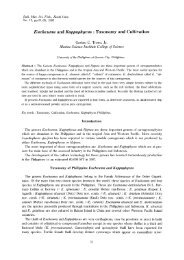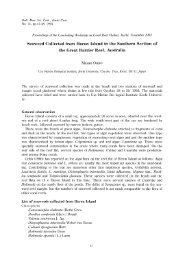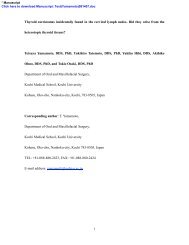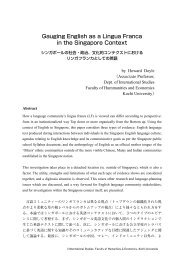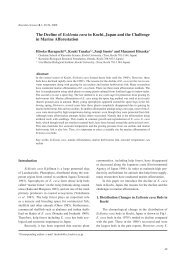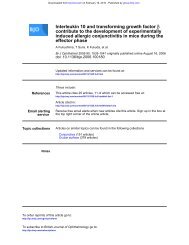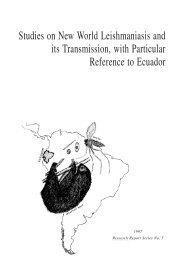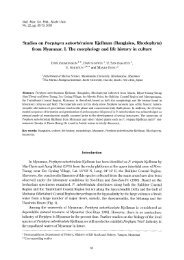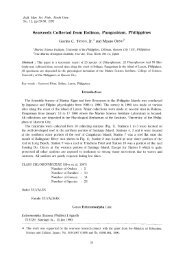50Ryoichi DOI, Pongsak SAHUNALU, Chongrak WACHRINRAT, Sakhan TEEJUNTUK and Katsutoshi SAKURAIchange <strong>in</strong> TN (Palmer & Young, 2000; Yang et al., 2001), pH (Flis et al. 1993) or BD (Li et al. 2002) may affect themultivariate <strong>soil</strong> microbial <strong>community</strong> profile. Some <strong>soil</strong> bacteria fix nitrogen (Albrecht et al. 1981), and others maycontribute to variations of <strong>soil</strong> pH, which leads to changes <strong>in</strong> other <strong>soil</strong> characteristics (Brown et al. 1994). BD is known to bealtered by macrofauna such as earthworms (Beare et al., 1995), while the contribution of microbes to the decrease <strong>in</strong> BD hasnot been shown. The altered <strong>soil</strong> <strong>bacterial</strong> <strong>community</strong> profile <strong>in</strong> BG is an effect of deforestation and degradation, and at thesame time, the changes <strong>in</strong> <strong>community</strong> structure (Fig. 2) and sole carbon source utilization patterns (Fig. 4c to f) may be thecause of the poor productivity of this <strong>soil</strong>.As the contrast between pH and TN shows (Fig. 5), <strong>soil</strong> microbial variables are not necessarily related to the <strong>soil</strong>environmental factors that most significantly reflect degradation, but may be related to ones that less significantly reflect<strong>in</strong>gthe impact (e.g., Jha et al. 1992). TC did not relate to <strong>soil</strong> <strong>bacterial</strong> <strong>community</strong> <strong>profiles</strong>, though deforestation comparablyaffected TC to TN (Table 1), which related to the <strong>profiles</strong>. While multiple <strong>soil</strong> biotic variables relate differently to the same<strong>soil</strong> environmental gradient (Jha et al. 1992), each <strong>soil</strong> biotic variable may relate differently to comparably significantenvironmental gradients (e.g., Donaldson & Henderson, 1990). Such complicated relationships lead to themultidimensionality of any gradient of our <strong>in</strong>terest (Ol<strong>in</strong>e & Grant, 2002). The difference <strong>in</strong> the relationship between thefirst RDA axis and the <strong>soil</strong> environmental factors aga<strong>in</strong> shows the multidimensionality as previously reported (Pankhurst etal. 2001; Hemerik & Brussaard, 2002). The ord<strong>in</strong>ation axes given by each method or AWCD value exist <strong>in</strong> the ord<strong>in</strong>ationspace <strong>in</strong> different locations (Fig. 5). The second RDA axis, derived from the data set on an AWCD of 0.2, as well as the firstRDA axis from that on an AWCD of 1.0, uniquely exits <strong>in</strong> the ord<strong>in</strong>ation space.In most cases, the criterion for the efficacy of a method for multivariate <strong>soil</strong> microbial profil<strong>in</strong>g was the separation of <strong>soil</strong>samples <strong>in</strong> the ord<strong>in</strong>ation diagram (e.g., Choi & Dobbs, 1999; Garland, 1996). In such a diagram, the most significantvariation is shown, while the residual variation is ignored. On the other hand, the Wilk’s lambda computation <strong>in</strong>volves all thevariation. The Biolog data set, at an AWCD of 1.0, apparently showed successful discrim<strong>in</strong>ation of the sample groups <strong>in</strong> thePC score plot (Fig. 4e), but the rest of the variation led to ambiguous discrim<strong>in</strong>ation accord<strong>in</strong>g to the Wilk’s lambda statistic(Table 2). M<strong>in</strong>or variation of a multivariate data set often gives useful <strong>in</strong>formation such as the <strong>in</strong>tegrated measure ofoccurrence of plant disease (Flancl, 1993) or above ground productivity (MacMillan, 1991). Thus, it is advantageous to f<strong>in</strong>dm<strong>in</strong>or variations, as well as the most significant ones. The low values of Wilk’s lambda show<strong>in</strong>g the high significance for theantibiotic methods <strong>in</strong>dicate that the aspects observed by these methods could f<strong>in</strong>d even m<strong>in</strong>or variations.Cultur<strong>in</strong>g techniques, as those used <strong>in</strong> this research, are sometimes criticized, because only a subset of <strong>soil</strong> <strong>bacterial</strong>population can be observed (Gray 1990). However, the subset has reflected <strong>soil</strong> environmental changes <strong>with</strong> patterns ofantibiotic resistance (Brønstad et al. 1996, Doyle & Stotzky 1993) and sole carbon source utilization (Insam & Rangger 1997).Thus, the subset provides <strong>in</strong>formation on how the communities respond to changes <strong>in</strong> their <strong>soil</strong> environments (Kennedy1994). A possibly more important limitation of the methods used <strong>in</strong> this research is that a portion of the <strong>bacterial</strong> <strong>community</strong>may contribute to plural variables. It will be worth compar<strong>in</strong>g the methods applied <strong>in</strong> this research <strong>with</strong> another that is freefrom this latent limitation (e.g. Fujie et al., 1998).The antibiotic methods are cost-effective and easy to perform, and the experimental conditions can be changed, e.g., bythe addition/substitution of antibiotics depend<strong>in</strong>g on availability. In this research, mixed antibiotics were shown to have arole different from the <strong>in</strong>dividual antibiotics <strong>in</strong> the profil<strong>in</strong>g and discrim<strong>in</strong>ation. Thus an additional variable, <strong>with</strong> an<strong>in</strong>dependent mean<strong>in</strong>g, may be obta<strong>in</strong>ed by mix<strong>in</strong>g antibiotics, allow<strong>in</strong>g the use of a smaller number of antibiotics. Thoughpreparation of the microtiter plate or the agar plate is more labor <strong>in</strong>tensive than the Biolog method, which uses the factorymadeproduct and gives several types of data (L<strong>in</strong>dstrom et al., 1998), the antibiotic methods do not need sophisticatedequipment, e.g., an ELISA plate reader which is a prerequisite for the Biolog method. Therefore, the antibiotic approach isan <strong>in</strong>expensive alternative for laboratories. Antibiotic resistance and/or susceptibility patterns of <strong>soil</strong> <strong>bacterial</strong> communitiesmay be directly l<strong>in</strong>ked to ecological conditions of the communities (Gottlieb, 1976; Stevenson, 1954). The Biolog methodprovided different RDA ord<strong>in</strong>ation planes and AWCD values. This <strong>in</strong>dicates that we should consider the mean<strong>in</strong>g of patternsof discrim<strong>in</strong>ation at some AWCD stages.ACKNOWLEDGEMENTS We thank the Sasakawa Scientific Research Grant from the Japan Science Society forf<strong>in</strong>ancial support. Mr. Pramuk Kaeoniam and other staff members of the SERS supported our activities. We gratefullyacknowledge their support.
Soil <strong>bacterial</strong> communities reflect<strong>in</strong>g land degradation51REFERENCESAcar, J. F. & Goldste<strong>in</strong>, F. W. 1996. Disk susceptibility test. In: Lorian, V. (ed.), Antibiotics <strong>in</strong> laboratory medic<strong>in</strong>e, 4th ed. pp.1-51. Williams and Wilk<strong>in</strong>s, Baltimore.Albrecht, S. L., Okon, Y., Lonnquist, J. & Burton, R. H. 1981. Nitrogen fixation by corn-Azospirillum association <strong>in</strong> atemperate climate. Crop Science 21: 301-306.Arana I, Muela A, Iriberri J, Egea L, Barc<strong>in</strong>a I, 1992. Role of hydrogen peroxide <strong>in</strong> loss of culturability mediated by visiblelight <strong>in</strong> Escherichia coli <strong>in</strong> a freshwater ecosystem. Applied and Environmental Microbiology 58: 3903-3907.Beare, M. H., Coleman, D. C., Crossley Jr., D. A., Hendrix, P. F. & Odum, E. P. 1995. A hierarchical approach to evaluat<strong>in</strong>gthe significance of <strong>soil</strong> biodivesity to biogeochemical cycl<strong>in</strong>g. Plant and Soil 170: 5-22.Bird, S. Coulson, R. N. & Crossley, Jr., D. A. 2000. Impacts of silvicultural practices on <strong>soil</strong> and litter arthropod diversity <strong>in</strong> aTexas p<strong>in</strong>e plantation. Forest Ecology and Management 131: 65-80.Blackwood, C. B., Marsh, T., Kim, S. H. & Paul, E. A., 2003. Term<strong>in</strong>al restriction fragment length polymorphism dataanalysis for quantitative comparison of microbial communities. Applied and Environmental Microbiology 69: 926-932.Borneman, J. & Triplett, E. W. 1997. Molecular microbial divesity <strong>in</strong> <strong>soil</strong>s from eastern Amasonia: evidence for unusualmicroorganisms and microbial population shifts <strong>associated</strong> <strong>with</strong> deforestation. Applied and Environmental Microbiology63: 2647-2653.Bossio, D. A. & Scow, K. M. 1995, Impact of carbon and flood<strong>in</strong>g on the metabolic diversity of microbial communities <strong>in</strong> <strong>soil</strong>s.Applied and Environmental Microbiology 61: 4043-4050.Brown, D. A., Choudari, D. K., Sawicki, J. A. and Beveridge, T. J. 1994. M<strong>in</strong>erals <strong>associated</strong> <strong>with</strong> biofilms occurr<strong>in</strong>g onexposed rock <strong>in</strong> a granitic underground research laboratory. Applied and Environmental Microbiology 60: 3182-3191.Brønstad, K., Drønen, K., Øvreås, L. & Torsvik, V. 1996. Phenotypic diversity and antibiotic resistance <strong>in</strong> <strong>soil</strong> <strong>bacterial</strong>communities. Journal of Industrial Microbiology 17: 253-259.Bubier, J. L. 1995. The relationship of vegetation to methane emission and hydrochemical gradients <strong>in</strong> northern peatlands.Journal of Ecology 83: 403-420.Bunyavejchew<strong>in</strong>, S. 1986. Ecological studies of tropical semi-evergreen ra<strong>in</strong> forest at Sakaerat, Nakhon Ratchasima,northeast Thailand, I vegetation patterns. Natural History Bullet<strong>in</strong> of Siam Society 34: 35-57.Choi, K-H. & Dobbs, F. C. 1999. Comparison of two k<strong>in</strong>ds of Biolog microplates (GN and ECO) <strong>in</strong> their ability to dist<strong>in</strong>guishamong aquatic microbial communities. Journal of Microbiological Methods 36: 203-213.Derylo, M. & Shorupska, A. 1992. Rhizobial siderophore as an iron source for clover. Physiologia Plantarum 85: 549-553.Doi, R. & Sakurai, K. 2002. Determ<strong>in</strong>ation of degradation gradient by profil<strong>in</strong>g <strong>soil</strong> <strong>bacterial</strong> communities <strong>in</strong> the SakaeratEnvironmental Research Station, Thailand. In Proc: 3rd International Symposium on Susta<strong>in</strong>able Agro-environmentalSystems: New Technologies and Applications. 26-29 Oct.Cairo.Doi, R. & Sakurai, K. 2003. Soil environmental factors relat<strong>in</strong>g to diversity of culturable <strong>soil</strong> <strong>bacterial</strong> communities <strong>in</strong> theSakaerat Environmental Research Station, Thailand. Tropics 12: 185-200.Donaldson, J. M. & Henderson, G. S. 1990. Nitrification potential of secondary-succession upland oak forests: I.m<strong>in</strong>eralization and nitrification dur<strong>in</strong>g laboratory <strong>in</strong>cubations. Soil Science Society of America Journal 54: 892-897.Doyle, J.D. & Stotzky, G. 1993. Methods for the detection of changes <strong>in</strong> the microbial ecology of <strong>soil</strong> caused by the<strong>in</strong>troduction of microorganisms. Microbial Releases 2: 63-72.Eden, M. J. & Parry, J. T. 1996. Land degradation <strong>in</strong> the tropics: environmental and policy issues. Global Development & theEnvironment series. P<strong>in</strong>ter, London, UKFlis, S. E., Glenn, A. R. & Dilworth, M. J. 1993. The <strong>in</strong>teraction between alm<strong>in</strong>ium and root nodule bacteria. Soil Biology andBiochemistry 25: 403-417.Francl, L. J. 1993. Multivariate analysis of selected edaphic factors and their relationship to Heterodera glyc<strong>in</strong>es populationdensity. Journal of Nematology 25: 270-276.Frostegård, Å., Tunlid, A & Bååth, E. 1993. Phospholipid fatty acid composition, biomass, and activity of microbialcomunities from two <strong>soil</strong> types experimentally exposed to different heavy metals. Applied and EnvironmentalMicrobiology 59: 3605-3617.Fujie, K., Hu, H.-Y., Tanaka, H., Urano, K., Saitou, K. & Katayama, A. 1998. Analysis of respiratory qu<strong>in</strong>ones <strong>in</strong> <strong>soil</strong> forcharacterization of microbiota. Soil Science and Plant Nutrition 44: 393-404.
- Page 2: 40Ryoichi DOI, Pongsak SAHUNALU, Ch
- Page 6 and 7: 44 Ryoichi DOI, Pongsak SAHUNALU, C
- Page 8 and 9: 46 Ryoichi DOI, Pongsak SAHUNALU, C
- Page 10 and 11: 48Ryoichi DOI, Pongsak SAHUNALU, Ch
- Page 14 and 15: 52Ryoichi DOI, Pongsak SAHUNALU, Ch



